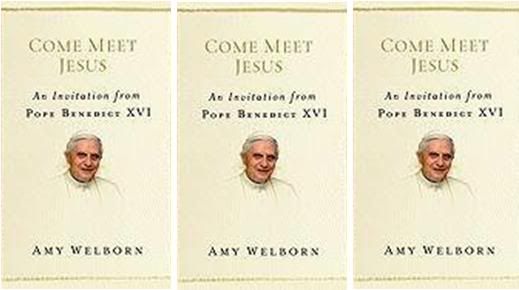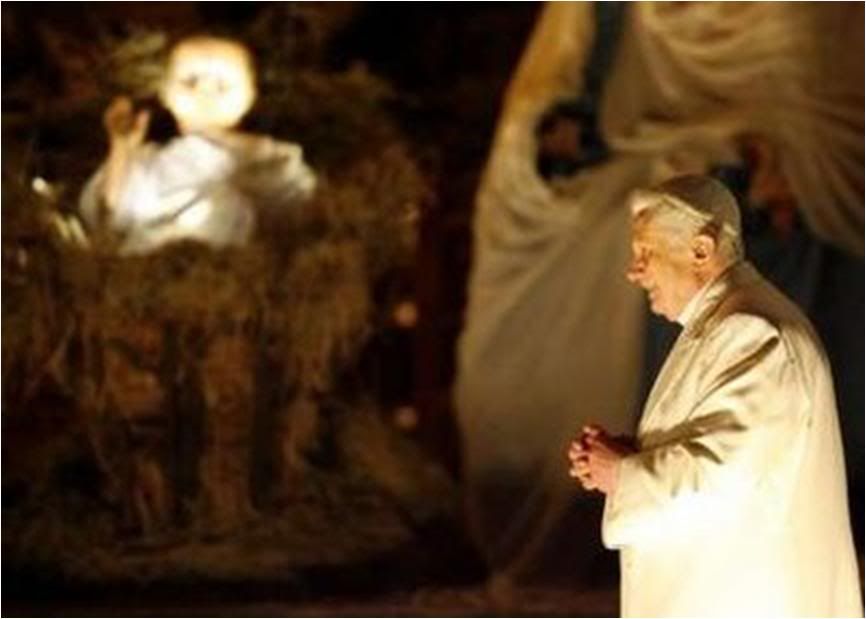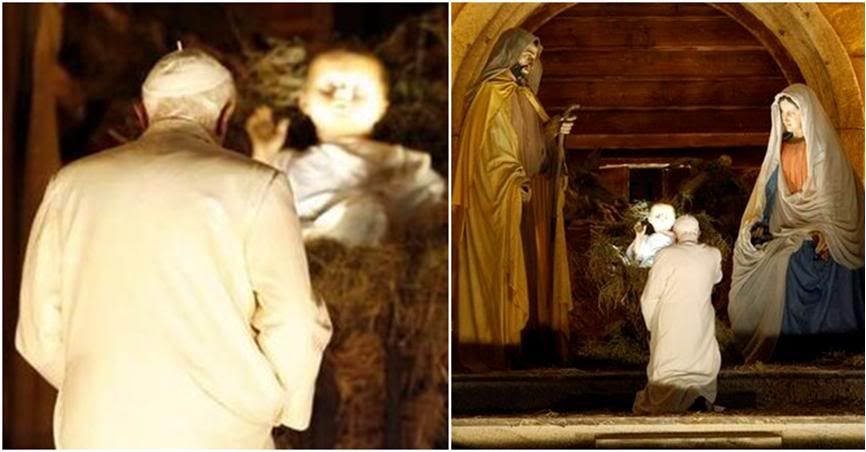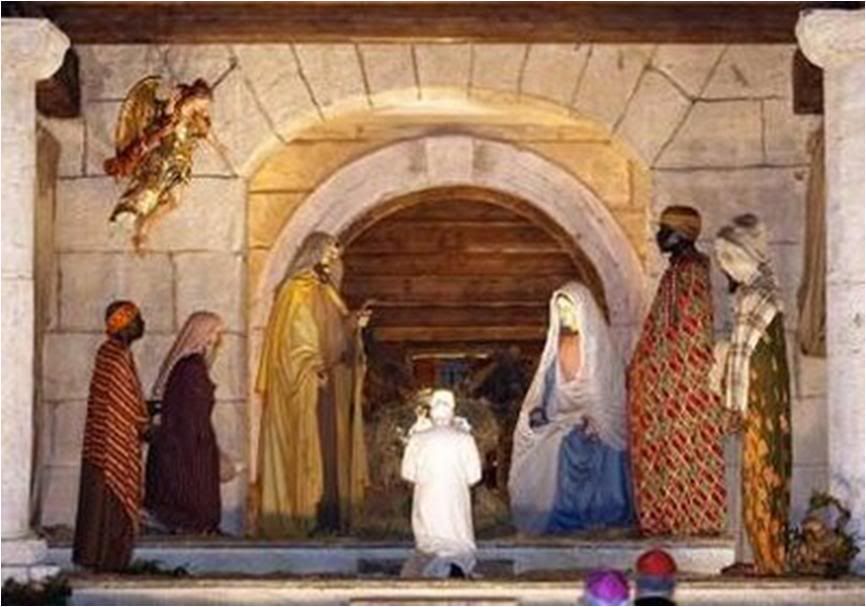

 What a pleasant Christmas surprise to find Amy Welborn writing for the Christmas issue of
What a pleasant Christmas surprise to find Amy Welborn writing for the Christmas issue of
the Catholic Herald! She has not completely given up blogging and you may follow her at
amywelborn.com.
 Among the things that have kept her busy is a new book coming out in January. Her article
Among the things that have kept her busy is a new book coming out in January. Her article
for the Herald ties in directly to the Holy Father's catechesis today...
Benedict XVI and the Christ Child
by AMY WELBORN

From the issue for
Dec. 25, 2009

The sentiment of the secular Christmas season might provoke a few mixed feelings. Although it seems ungrateful not to be, well... grateful that despite the unrelenting merchandising and secularisation, the basic points of love and giving seem to hold.
On the other hand, Love who? Why? How? We know how even words about the highest truths can be drained of meaning and manipulated for base or even evil ends.
So we do sense the truth and promise of Christmas. But mired in postmodern vacuity and scepticism, we wonder, indeed, what we really could possibly mean as we sing: "Holy Infant, so tender and mild..."
And what does that long-ago event it have to do with my life, right now?
Enter Pope Benedict and the Child.
The Holy Father, we all know very well, is a brilliant theologian, but that is not as intimidating as it sounds. For with theologian Joseph Ratzinger, whose writing is consistently lucid, humble and even charming, the line between "theology" and "spiritual writing" frequently slips and even disappears.
So in a meditation composed during his time as Archbishop of Munich, Joseph Ratzinger, beginning as he often does from something quite concrete, reflected on the devotion to an image of the Christ Child still preserved in a tree in Christkindl, placed there in the 17th century by a man suffering from epilepsy or, as the chronicler terms it, "the sickness where one falls down".
A church was eventually built around the tree, and devotion grew. Sweet, but is there anything more than sentimental piety here?
Well, yes. Ratzinger, in just a few words, links this tree with the tree of paradise, with Mary, the life-giving tree who gives us the fruit, Jesus, with the circular shape of the church, recalling the womb and baptism, our call to be born again as children, which is possible because God became a child.
For, as he writes, in a passage that never ceases to prompt me to pause in recognition, "we are all suffering from 'the sickness where one falls down'".
How true. How very true.
"Again and again, we find ourselves unable interiorly to walk upright and to stand. Again and again, we fall down; we are not masters of our own lives; we are alienated; we are not free."
What is the answer? God's love - and there is nothing vague about this. God's love so very real and concrete that it is enfleshed and God himself comes to earth in the most startling of ways - as a baby.
We need not look far for the "tree" holding the baby, Ratzinger says, the One who heals us from the sickness where we fall down: "Jesus, who is himself the fruit of the tree of life, and life itself, has becomes so small that our hands can enclose him", we can know him - and be redeemed.
In another meditation, then-Archbishop Ratzinger highlights St Francis of Assisi's role in shaping Christmas devotion in his creation of the original crèche at Greccio.

He points to the radical implications of the Word-Made-Flesh as a Child, that this is not about mere sentiment, but about how we must be: "his existence as a child shows us how we come to God and to deification ... One who has not grasped the mystery of Christmas has failed to grasp the decisive element in Christianity" - that to enter the Kingdom we must become like Him. Like a child.
As we continue to read what the Holy Father writes about the Christ Child in his homilies as Pope, the same idea emerges again and again: if we want to know who God is, look at the Child.
If we, in our emptiness, sin and hopelessness, want to know if our lives have meaning and if we are loved, look to the Child.
If we want to know how to love, look to the Child.
Most important of all, if we want to not just have the right ideas, but to actually live in love now and forever, know and love the Child. At Midnight Mass in 2006, the Holy Father's words bring the Good News about God, us and this broken world:
"God's sign is simplicity. God's sign is the baby. God's sign is that he makes himself small for us. This is how he reigns. He does not come with power and outward splendour. He comes as a baby - defenceless and in need of our help.
He does not want to overwhelm us with his strength. He takes away our fear of his greatness. He asks for our love: so he makes himself a child. He wants nothing other from us than our love, through which we spontaneously learn to enter into his feelings, his thoughts and his will - we learn to live with him and to practise with him that humility of renunciation that belongs to the very essence of love. God made himself small so that we could understand him, welcome him, and love him."
My own favourite object of Christmas meditation is a real, actual baby. Now that I have none of my own, I must seek one out - at a Catholic Mass that is not too hard - and consider the tiny thing, eyes wide open staring at me and the rest of the world, or closed in blissful sleep, nestled against its mother's neck.
"God is so great that he can become small," Pope Benedict said at Midnight Mass in 2005. "God is so powerful that he can make himself vulnerable and come to us as a defenceless child, so that we can love him. God is so good that he can give up his divine splendour and come down to a stable, so that we might find him, so that his goodness might touch us, give itself to us and continue to work through us. This is Christmas: 'You are my son, this day I have begotten you'. God has become one of us, so that we can be with him and become like him. As a sign, he chose the Child lying in the manger: this is how God is. This is how we come to know him."
Real. Concrete. Flesh and blood. In such loving helplessness, helping us walk, because we have, indeed, all fallen down.
 The photos I used to illustrate this article are from the Holy Father's visit to the Nativity scene at the Piazza on 12/23/08.
The photos I used to illustrate this article are from the Holy Father's visit to the Nativity scene at the Piazza on 12/23/08.
[Modificato da TERESA BENEDETTA 24/12/2009 14:30]